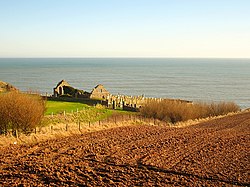Chapel of St Mary and St Nathalan
| The Chapel of St Mary and St Nathalan | |
|
Kincardineshire | |
|---|---|
 'St Mary of the Storms' by Cowrie in Kincardineshire | |
| Type: | Chapel |
| Location | |
| Grid reference: | NO88438732 |
| Location: | 56°58’37"N, 2°11’31"W |
| History | |
| Chapel | |
| Information | |
| Condition: | Ruined |
The Chapel of St Mary and St Nathalan is a ruined chapel overlooking the North Sea immediately north of Stonehaven, in Kincardineshire, along the northern shoreline of Stonehaven Bay.[1] It is alternatively known as 'Cowie Chapel' and more tellingly as ‘St Mary’s of the Storms’.[2]
The foundation of this chapel is associated with St Nathalan, who lived around the year 650.
The chapel is at the point where the Highland Boundary Fault meets the sea and so is on the dividing line between the highlands and lowlands of Scotland.
History
The Chapel of St Mary and St Nathalan is one of the oldest surviving structures in Kincardineshire. It stands just half a mile from the ancient Causey Mounth trackway, which was constructed on high ground to make passable this only available medieval route from coastal points south of Stonehaven into Aberdeen.
St Nathalan or Nachlan, is reputed to have built the first small chapel on this windswept clifftop during the 7th century, but fact about Nachlan are scarse, legend fills in the gaps, telling us that he was a preacher of the Word and a teacher schooling farmers in the cultivation of the rough moorlands.
Nathalan also built churches at Coull and Tullich on Deeside. He died around 678 and is believed to have been buried at Tullich.
A narrow footbridge spans the Kirk Burn today by the chapel, but in past times travellers crossed by the ford in the den below the chapel. A path linked the chapel to Cowie Castle, which stood on the cliff top some 200 yards to the south
Several Kings of Scotland, in particular James IV, frequently worshipped here and gave generous donations to the chapel.[2]
The chapel fell into disuse soon after the Reformation. It is recorded that it “was unroofed by the ecclesiastical authority on account of certain scandals”. The local people then begin to take stones from the walls for building purposes despite a legend that the stones would rain drops of blood upon any house built with them. The lintel from above the main doorway is reputed to have been removed several times but each time mysteriously reappeared in its original position; it has, however, been missing for many years.[2]
Outside links
- The Chapel of St Mary and St Nathalan: St Mary’s, Stonehaven
References
- Watt, Archibald: 'Highways and Byways around Kincardineshire' (Stonehaven Heritage Society, 1985)
- Megalithic Portal: Causey Mounth
- ↑ Watt, 1985
- ↑ 2.0 2.1 2.2 St Mary’s of the Storms: St Mary’s, Stonehaven